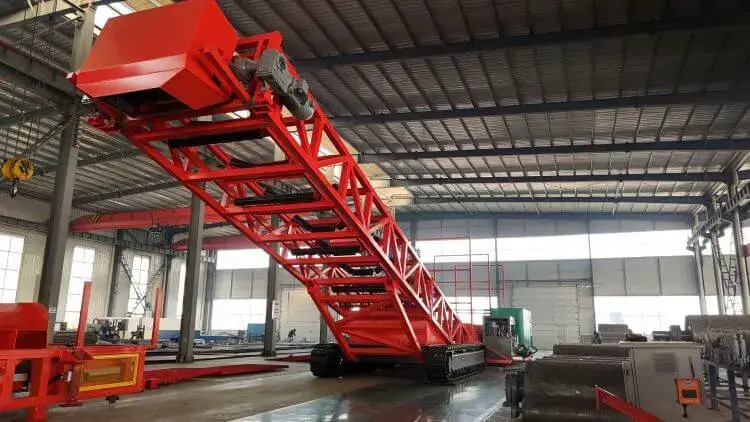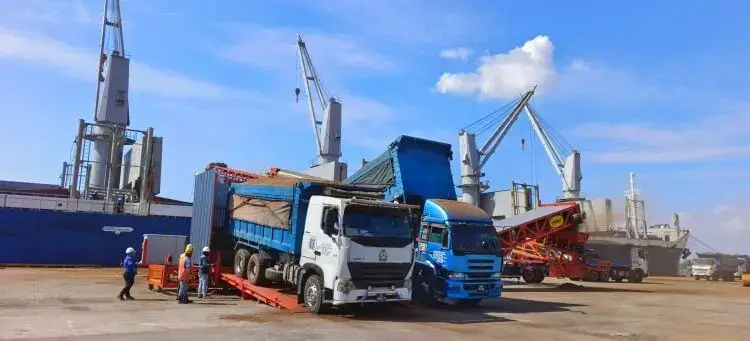Time:2025-08-14 15:35:06 Number of Clicks:
In the global bulk material conveying system, traditional truck unloading methods, such as manual operation or assistance with simple bulldozers and loaders, often face many pain points such as low efficiency, severe dust pollution, multiple safety hazards, large site occupation, and high material loss. Therefore, using a truck unloader as a device connecting road transportation and subsequent processing links can effectively improve the efficiency of bulk material unloading, reduce labor costs, and ensure operational safety.

Truck unloader, also known as truck unloader, dump truck unloading system or mobile unloading station, is an integrated equipment system specially designed for quickly and efficiently receiving, conveying and transferring bulk materials from the carriage of dump trucks (or rigid trucks). It usually integrates material receiving devices (such as hoppers), primary feeding equipment (such as vibrating feeders, plate feeders), main conveyors (usually belt conveyors), traveling mechanisms (crawler or tire type), lifting mechanisms, and necessary dust removal systems and control systems.
There are many types of truck unloader bulk material handling equipment, and different types of equipment have certain differences in working principles. Common ones include hydraulic tilting plate type, chain plate type, screw type, etc.
Hydraulic tilting plate truck unloaders mainly rely on hydraulic systems to realize the unloading action. Its working process is roughly as follows: First, the truck drives the carriage filled with bulk materials to the designated position of the unloader, and the positioning device ensures that the truck is parked stably and accurately. Then, the hydraulic system is started, and the hydraulic pump starts to work, delivering hydraulic oil into the hydraulic cylinder through the oil pipe. Under the pressure of hydraulic oil, the piston rod of the hydraulic cylinder extends, pushing the platform carrying the truck to rise slowly. As the angle of the platform gradually increases, the bulk materials in the carriage slide out of the carriage under the action of gravity and fall into the conveying equipment or storage area below. After unloading, the hydraulic system operates in reverse, the piston rod retracts, and the platform returns to its initial position to allow the next truck to unload.
The pressure and lifting speed of the hydraulic system of the hydraulic tilting plate truck unloader can be adjusted according to the type of bulk materials and the weight of the carriage to ensure the stability and safety of the unloading process. At the same time, in order to prevent the truck from sliding during unloading, the equipment is usually equipped with reliable anti-skid devices.
The chain plate truck unloader is mainly composed of chains, chain plates, driving devices, tensioning devices and other parts. During operation, the chain plate is extended into the truck's silo, the driving device drives the chain to rotate, and the chain then drives the chain plate to move. During the movement of the chain plate, it continuously scrapes and conveys the bulk materials out of the silo, and through the continuous operation of the chain plate, the continuous unloading of bulk materials is realized.
The chain plates of the chain plate unloader are made of high-strength materials, which have strong wear resistance and bearing capacity, and can adapt to the unloading of various bulk materials, such as coal, ore, grain, etc. The tensioning device can ensure the tension of the chain and avoid the chain loosening from affecting the unloading efficiency.
The core component of the screw type truck unloader is the screw blade, and its working principle is similar to that of a screw conveyor. When the equipment is started, the motor drives the screw blade to rotate. During the rotation of the screw blade, it will generate an axial thrust on the bulk material, making the bulk material move along the axis direction of the screw blade. When the truck is unloading, the feed port of the screw conveyor is extended into the truck's silo, and the bulk materials are pushed by the screw blade and discharged from the discharge port to complete the unloading operation.
The screw blades of the screw unloader have different pitches and diameters, which can be selected according to the characteristics of the bulk materials (such as particle size, humidity, viscosity, etc.) to improve unloading efficiency. In addition, the screw unloader can also control the unloading speed by adjusting the rotation speed of the motor.
Zoomry Heavy Industry's mobile truck unloader is a comprehensive equipment integrating hydraulic assistance, gravity unloading and belt conveying. Its design combines the flexible control of the hydraulic tilting plate type and the continuous transfer capacity of the belt conveyor, making it more suitable for large-scale bulk material handling scenarios.
The core logic of the equipment is: adjust the working posture through the hydraulic system, realize material unloading by using the truck's self-unloading action and gravity, and then transfer the materials to subsequent equipment (such as stackers, ship loaders) through the belt conveyor, forming an integrated "unloading-conveying" process, which perfectly adapts to the efficient transfer needs of mines, quarries, ports, etc. The working process of Zoomry Heavy Industry's truck unloader can be divided into several stages, and each link cooperates to achieve efficient unloading:
Traditional manual unloading methods not only have high labor intensity but also low unloading efficiency, which often cannot meet the needs of large-scale bulk material handling. The truck unloader adopts mechanized operation, which can realize continuous and rapid unloading. Zoomry Heavy Industry's efficient truck unloader equipment provides two chassis options: wheeled (ZRLS-TU series) and crawler (ZRLD-TU series): wheeled is suitable for quick transfer on hardened roads, and crawler can adapt to complex terrains such as mines and construction sites, meeting the mobility needs of different sites. At the same time, the configuration of 2 or 4 truck ramps supports a single device to serve multiple trucks at the same time, greatly improving unloading efficiency. It can unload 1800 tons of bulk materials per hour, which greatly shortens the unloading time and improves the efficiency of the entire bulk material handling process.
Manual unloading requires a lot of labor, and with the continuous increase of labor costs, the cost of manual unloading is also getting higher and higher. Using a truck unloader can reduce reliance on labor. A single device usually only requires 1-2 operators to complete the unloading operation, which significantly reduces labor costs and avoids material waste and equipment damage caused by improper manual operation.
During the unloading process of bulk materials, especially some bulk materials such as ore and coal, manual unloading has great safety hazards and is prone to casualties. The truck unloader is equipped with a wireless remote control function, allowing operators to remotely control actions such as ramp adjustment and belt start/stop, reducing the risk of on-site contact. The design of hydraulic jacks and a stable chassis ensures that the equipment does not shake when the truck is unloading, reducing the risk of rollover; the hopper grille and diversion structure prevent material splashing, improving operational safety.
Different bulk materials have different physical properties, such as particle size, humidity, viscosity, etc. The truck unloader can adapt to the unloading needs of various bulk materials by replacing different components or adjusting relevant parameters. Whether it is dry granular materials or wet powdery materials, they can be effectively unloaded.
Relying on the combination mode of "gravity unloading + belt conveying", the equipment does not require additional power to drive material stripping. With a "climbing angle of ≤6.7deg", it reduces energy loss during truck unloading. The wide range of processing capacity from 200 to 1800tph can match the different production capacity needs from small and medium-sized to large ports.
The truck unloader can be seamlessly connected with other bulk material conveying equipment such as belt conveyors, telescopic stackers, and mobile ship loaders, forming a complete bulk material handling system. After being unloaded by the truck unloader, the materials are directly conveyed, stored or loaded by subsequent conveying equipment, realizing the automation and continuity of bulk material handling and improving the operating efficiency of the entire system.

As an international supplier focusing on the R&D and manufacturing of bulk material conveying equipment, Zoomry Heavy Industry deeply understands the efficiency, cost, environmental protection and safety challenges faced by global customers in the bulk material loading and unloading link. Our truck unloader product line integrates innovative design concepts, strict quality control and rich project experience:
Through precise mechanical design, intelligent control systems and efficient dust removal schemes, truck unloaders have completely innovated the traditional truck unloading mode, bringing significant efficiency improvement, cost saving, environmental improvement and safety guarantee to many industries such as mines, power plants, cement plants, port terminals, grain storage, and fertilizer production.
With profound technical accumulation and accurate grasp of global market demand, Zoomry Heavy Industry is committed to providing customers with high-performance, high-reliability and cost-effective truck unloaders and complete bulk material handling solutions. We are not only equipment suppliers but also reliable partners for customers to improve bulk material logistics efficiency and achieve sustainable development.
Copyright © 2002-2024 Zoomry Group Company Limited